washer fluid JEEP CHEROKEE 2021 Owner handbook (in English)
[x] Cancel search | Manufacturer: JEEP, Model Year: 2021, Model line: CHEROKEE, Model: JEEP CHEROKEE 2021Pages: 332, PDF Size: 8.87 MB
Page 12 of 332
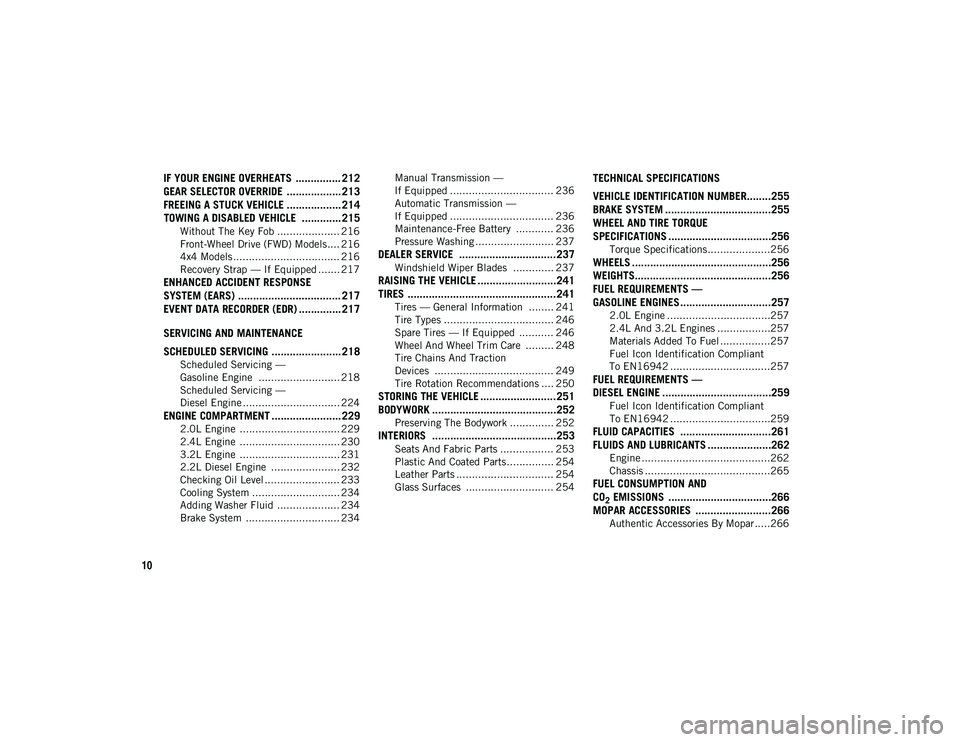
10
IF YOUR ENGINE OVERHEATS ............... 212
GEAR SELECTOR OVERRIDE .................. 213FREEING A STUCK VEHICLE .................. 214TOWING A DISABLED VEHICLE ............. 215
Without The Key Fob .................... 216
Front-Wheel Drive (FWD) Models .... 216
4x4 Models .................................. 216
Recovery Strap — If Equipped ....... 217
ENHANCED ACCIDENT RESPONSE
SYSTEM (EARS) .................................. 217
EVENT DATA RECORDER (EDR) .............. 217
SERVICING AND MAINTENANCE
SCHEDULED SERVICING ....................... 218
Scheduled Servicing —
Gasoline Engine .......................... 218 Scheduled Servicing —
Diesel Engine ............................... 224
ENGINE COMPARTMENT ....................... 229
2.0L Engine ................................ 229
2.4L Engine ................................ 230
3.2L Engine ................................ 231
2.2L Diesel Engine ...................... 232
Checking Oil Level ........................ 233
Cooling System ............................ 234
Adding Washer Fluid .................... 234
Brake System .............................. 234 Manual Transmission —
If Equipped ................................. 236 Automatic Transmission —
If Equipped ................................. 236 Maintenance-Free Battery ............ 236
Pressure Washing ......................... 237
DEALER SERVICE ................................237
Windshield Wiper Blades ............. 237
RAISING THE VEHICLE ..........................241
TIRES .................................................241
Tires — General Information ........ 241
Tire Types ................................... 246
Spare Tires — If Equipped ........... 246
Wheel And Wheel Trim Care ......... 248
Tire Chains And Traction
Devices ...................................... 249 Tire Rotation Recommendations .... 250
STORING THE VEHICLE .........................251BODYWORK .........................................252
Preserving The Bodywork .............. 252
INTERIORS .........................................253
Seats And Fabric Parts ................. 253
Plastic And Coated Parts............... 254
Leather Parts ............................... 254
Glass Surfaces ............................ 254
TECHNICAL SPECIFICATIONS
VEHICLE IDENTIFICATION NUMBER........255BRAKE SYSTEM ...................................255
WHEEL AND TIRE TORQUE
SPECIFICATIONS ..................................256
Torque Specifications ....................256
WHEELS ..............................................256
WEIGHTS.............................................256
FUEL REQUIREMENTS —
GASOLINE ENGINES ..............................257
2.0L Engine .................................257
2.4L And 3.2L Engines .................257
Materials Added To Fuel ................257
Fuel Icon Identification Compliant
To EN16942 ................................257
FUEL REQUIREMENTS —
DIESEL ENGINE ....................................259
Fuel Icon Identification Compliant
To EN16942 ................................259
FLUID CAPACITIES ..............................261
FLUIDS AND LUBRICANTS .....................262
Engine .........................................262
Chassis ........................................265
FUEL CONSUMPTION AND
CO
2 EMISSIONS ..................................266
MOPAR ACCESSORIES .........................266
Authentic Accessories By Mopar .....266
2020_JEEP_CHEROKEE_UG_RHD_UK.book Page 10
Page 36 of 332
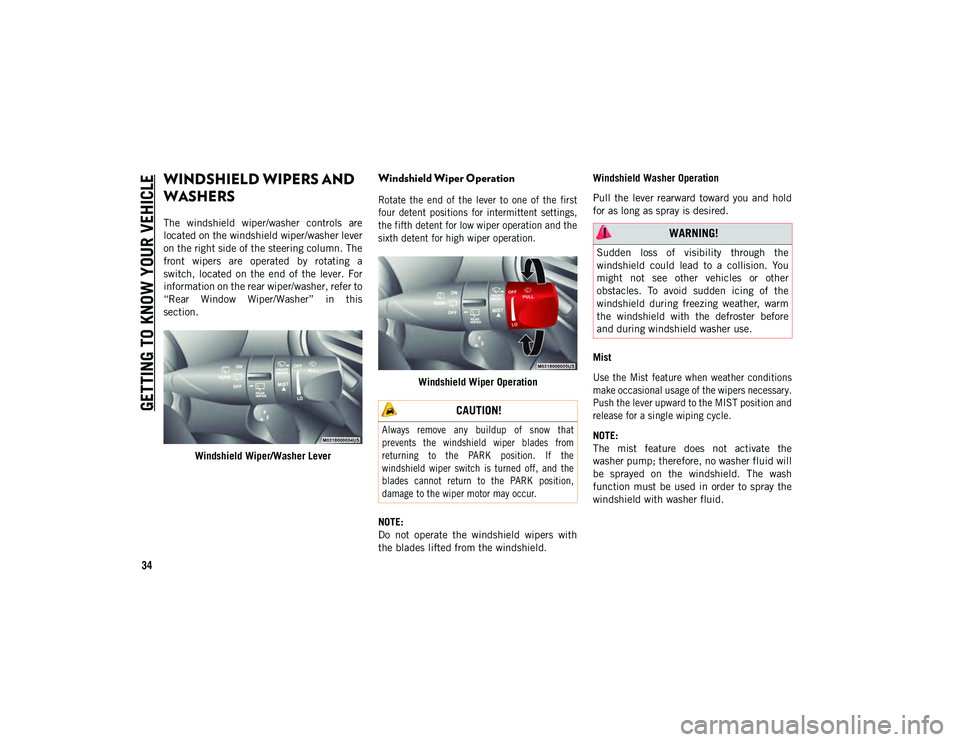
GETTING TO KNOW YOUR VEHICLE
34
WINDSHIELD WIPERS AND
WASHERS
The windshield wiper/washer controls are
located on the windshield wiper/washer lever
on the right side of the steering column. The
front wipers are operated by rotating a
switch, located on the end of the lever. For
information on the rear wiper/washer, refer to
“Rear Window Wiper/Washer” in this
section.Windshield Wiper/Washer Lever
Windshield Wiper Operation
Rotate the end of the lever to one of the first
four detent positions for intermittent settings,
the fifth detent for low wiper operation and the
sixth detent for high wiper operation.
Windshield Wiper Operation
NOTE:
Do not operate the windshield wipers with
the blades lifted from the windshield. Windshield Washer Operation
Pull the lever rearward toward you and hold
for as long as spray is desired.
Mist
Use the Mist feature when weather conditions
make occasional usage of the wipers necessary.
Push the lever upward to the MIST position and
release for a single wiping cycle.
NOTE:
The mist feature does not activate the
washer pump; therefore, no washer fluid will
be sprayed on the windshield. The wash
function must be used in order to spray the
windshield with washer fluid.
CAUTION!
Always remove any buildup of snow that
prevents the windshield wiper blades from
returning to the PARK position. If the
windshield wiper switch is turned off, and the
blades cannot return to the PARK position,
damage to the wiper motor may occur.
WARNING!
Sudden loss of visibility through the
windshield could lead to a collision. You
might not see other vehicles or other
obstacles. To avoid sudden icing of the
windshield during freezing weather, warm
the windshield with the defroster before
and during windshield washer use.
2020_JEEP_CHEROKEE_UG_RHD_UK.book Page 34
Page 70 of 332
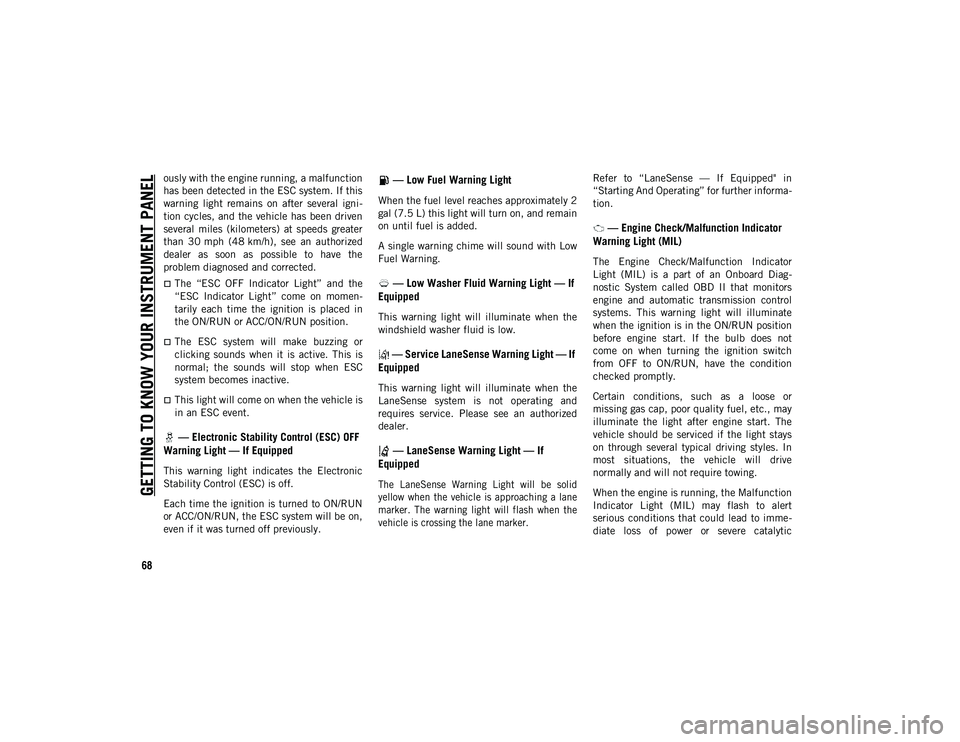
GETTING TO KNOW YOUR INSTRUMENT PANEL
68
ously with the engine running, a malfunction
has been detected in the ESC system. If this
warning light remains on after several igni-
tion cycles, and the vehicle has been driven
several miles (kilometers) at speeds greater
than 30 mph (48 km/h), see an authorized
dealer as soon as possible to have the
problem diagnosed and corrected.
The “ESC OFF Indicator Light” and the
“ESC Indicator Light” come on momen -
tarily each time the ignition is placed in
the ON/RUN or ACC/ON/RUN position.
The ESC system will make buzzing or
clicking sounds when it is active. This is
normal; the sounds will stop when ESC
system becomes inactive.
This light will come on when the vehicle is
in an ESC event.
— Electronic Stability Control (ESC) OFF
Warning Light — If Equipped
This warning light indicates the Electronic
Stability Control (ESC) is off.
Each time the ignition is turned to ON/RUN
or ACC/ON/RUN, the ESC system will be on,
even if it was turned off previously.
— Low Fuel Warning Light
When the fuel level reaches approximately 2
gal (7.5 L) this light will turn on, and remain
on until fuel is added.
A single warning chime will sound with Low
Fuel Warning.
— Low Washer Fluid Warning Light — If
Equipped
This warning light will illuminate when the
windshield washer fluid is low.
— Service LaneSense Warning Light — If
Equipped
This warning light will illuminate when the
LaneSense system is not operating and
requires service. Please see an authorized
dealer.
— LaneSense Warning Light — If
Equipped
The LaneSense Warning Light will be solid
yellow when the vehicle is approaching a lane
marker. The warning light will flash when the
vehicle is crossing the lane marker.
Refer to “LaneSense — If Equipped" in
“Starting And Operating” for further informa
-
tion.
— Engine Check/Malfunction Indicator
Warning Light (MIL)
The Engine Check/Malfunction Indicator
Light (MIL) is a part of an Onboard Diag -
nostic System called OBD II that monitors
engine and automatic transmission control
systems. This warning light will illuminate
when the ignition is in the ON/RUN position
before engine start. If the bulb does not
come on when turning the ignition switch
from OFF to ON/RUN, have the condition
checked promptly.
Certain conditions, such as a loose or
missing gas cap, poor quality fuel, etc., may
illuminate the light after engine start. The
vehicle should be serviced if the light stays
on through several typical driving styles. In
most situations, the vehicle will drive
normally and will not require towing.
When the engine is running, the Malfunction
Indicator Light (MIL) may flash to alert
serious conditions that could lead to imme -
diate loss of power or severe catalytic
2020_JEEP_CHEROKEE_UG_RHD_UK.book Page 68
Page 221 of 332
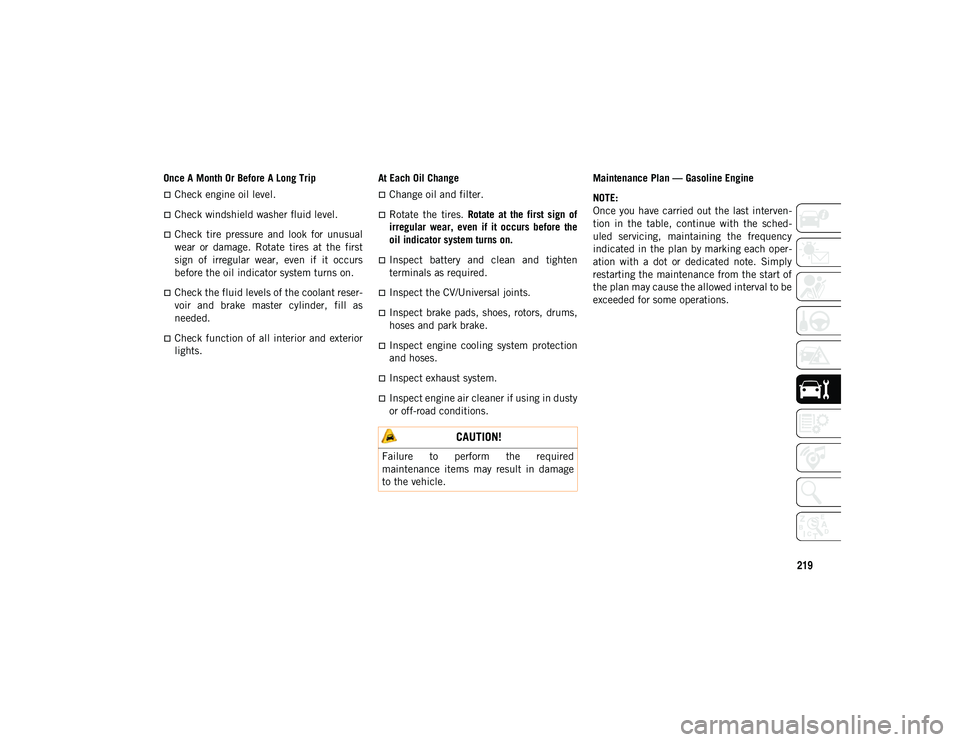
219
Once A Month Or Before A Long Trip
Check engine oil level.
Check windshield washer fluid level.
Check tire pressure and look for unusual
wear or damage. Rotate tires at the first
sign of irregular wear, even if it occurs
before the oil indicator system turns on.
Check the fluid levels of the coolant reser-
voir and brake master cylinder, fill as
needed.
Check function of all interior and exterior
lights. At Each Oil Change
Change oil and filter.
Rotate the tires.
Rotate at the first sign of
irregular wear, even if it occurs before the
oil indicator system turns on.
Inspect battery and clean and tighten
terminals as required.
Inspect the CV/Universal joints.
Inspect brake pads, shoes, rotors, drums,
hoses and park brake.
Inspect engine cooling system protection
and hoses.
Inspect exhaust system.
Inspect engine air cleaner if using in dusty
or off-road conditions. Maintenance Plan — Gasoline Engine
NOTE:
Once you have carried out the last interven
-
tion in the table, continue with the sched -
uled servicing, maintaining the frequency
indicated in the plan by marking each oper -
ation with a dot or dedicated note. Simply
restarting the maintenance from the start of
the plan may cause the allowed interval to be
exceeded for some operations.
CAUTION!
Failure to perform the required
maintenance items may result in damage
to the vehicle.
2020_JEEP_CHEROKEE_UG_RHD_UK.book Page 219
Page 227 of 332

225
Once A Month Or Before A Long Trip
Check engine oil level.
Check windshield washer fluid level.
Check tire pressure and look for unusual
wear or damage. Rotate tires at the first
sign of irregular wear, even if it occurs
before the oil indicator system turns on.
Check the fluid levels of the coolant reser-
voir and brake master cylinder, fill as
needed.
Check function of all interior and exterior
lights.
Control and recovery of additive level for
AdBlue® Diesel emissions (UREA) (if
equipped) At Each Oil Change
Change the engine oil filter.
Inspect the brake hoses and lines.
Inspect for the presence of water in the
fuel filter/water separator unit.
Inspect the CV/Universal joints.
Demanding Vehicle Use
Restore additive level for AdBlue® Diesel
emissions (UREA) (if equipped), when the
lamp is illuminated or the message on the
instrument panel.
Maintenance Plan — Diesel Engine
NOTE:
Once you have carried out the last interven -
tion in the table, continue with the sched -
uled servicing, maintaining the frequency
indicated in the plan by marking each oper -
ation with a dot or dedicated note. Simply
restarting the maintenance from the start of
the plan may cause the allowed interval to be
exceeded for some operations.
CAUTION!
Failure to perform the required
maintenance items may result in damage
to the vehicle.
2020_JEEP_CHEROKEE_UG_RHD_UK.book Page 225
Page 231 of 332
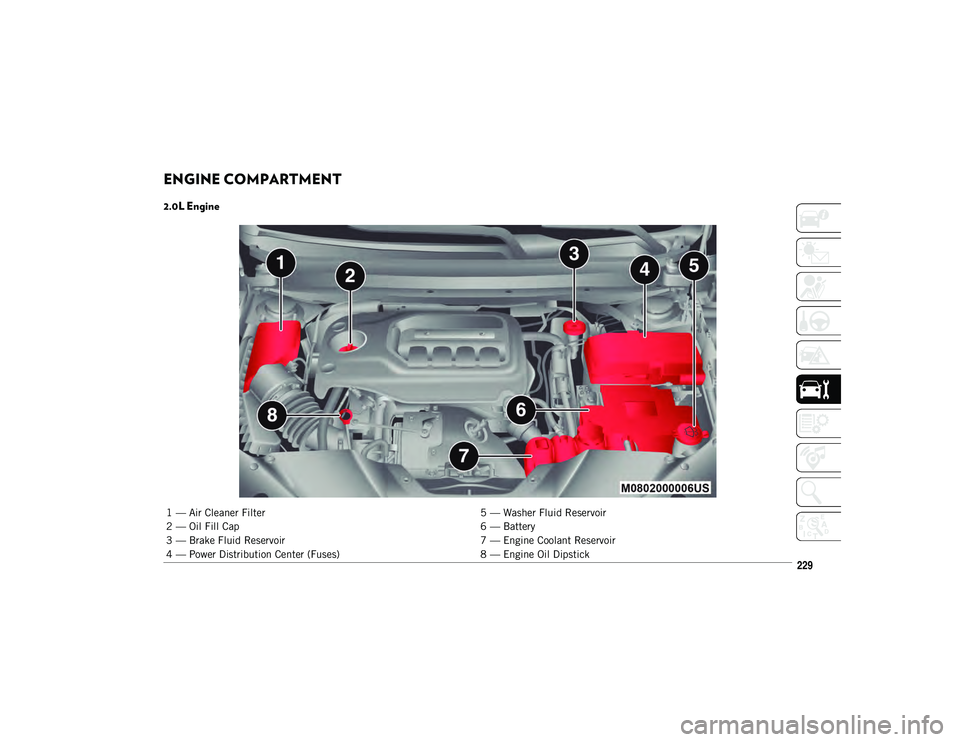
229
ENGINE COMPARTMENT
2.0L Engine
1 — Air Cleaner Filter5 — Washer Fluid Reservoir
2 — Oil Fill Cap 6 — Battery
3 — Brake Fluid Reservoir 7 — Engine Coolant Reservoir
4 — Power Distribution Center (Fuses) 8 — Engine Oil Dipstick
2020_JEEP_CHEROKEE_UG_RHD_UK.book Page 229
Page 232 of 332
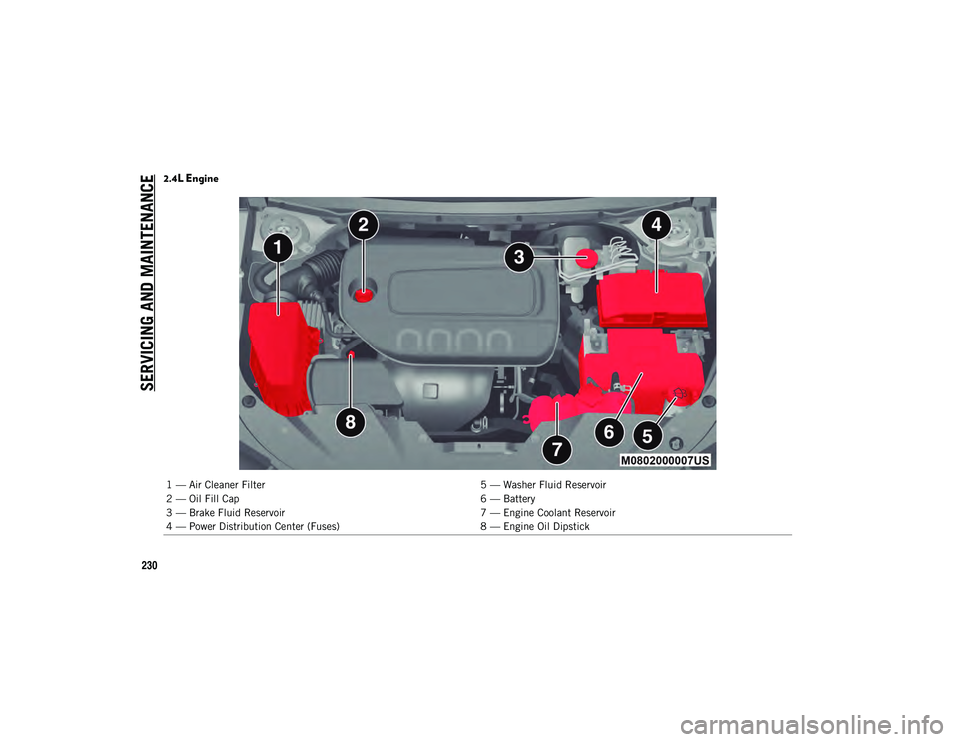
SERVICING AND MAINTENAN
CE
230
2.4L Engine
1 — Air Cleaner Filter5 — Washer Fluid Reservoir
2 — Oil Fill Cap 6 — Battery
3 — Brake Fluid Reservoir 7 — Engine Coolant Reservoir
4 — Power Distribution Center (Fuses) 8 — Engine Oil Dipstick
2020_JEEP_CHEROKEE_UG_RHD_UK.book Page 230
Page 233 of 332
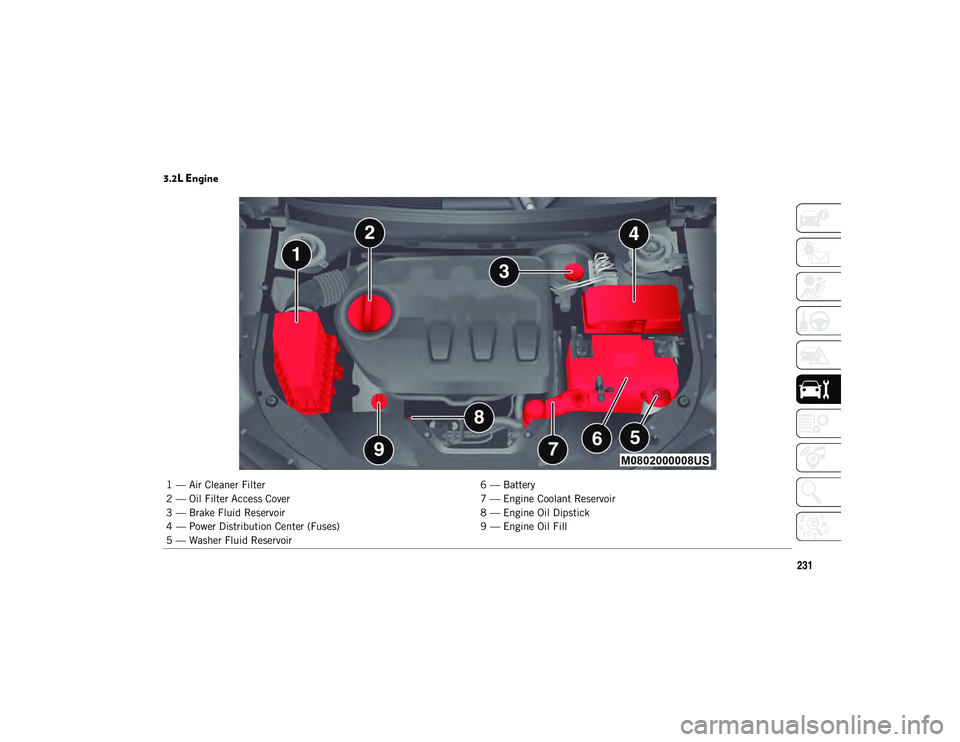
231
3.2L Engine
1 — Air Cleaner Filter6 — Battery
2 — Oil Filter Access Cover 7 — Engine Coolant Reservoir
3 — Brake Fluid Reservoir 8 — Engine Oil Dipstick
4 — Power Distribution Center (Fuses) 9 — Engine Oil Fill
5 — Washer Fluid Reservoir
2020_JEEP_CHEROKEE_UG_RHD_UK.book Page 231
Page 234 of 332
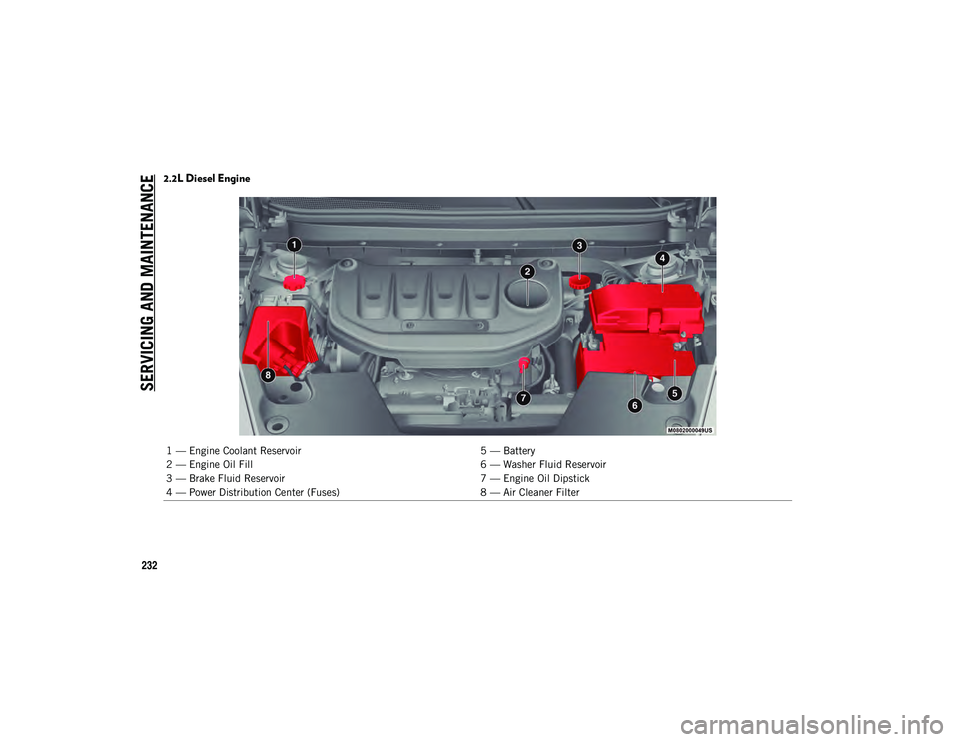
SERVICING AND MAINTENAN
CE
232
2.2L Diesel Engine
1 — Engine Coolant Reservoir5 — Battery
2 — Engine Oil Fill 6 — Washer Fluid Reservoir
3 — Brake Fluid Reservoir 7 — Engine Oil Dipstick
4 — Power Distribution Center (Fuses) 8 — Air Cleaner Filter
2020_JEEP_CHEROKEE_UG_RHD_UK.book Page 232
Page 236 of 332
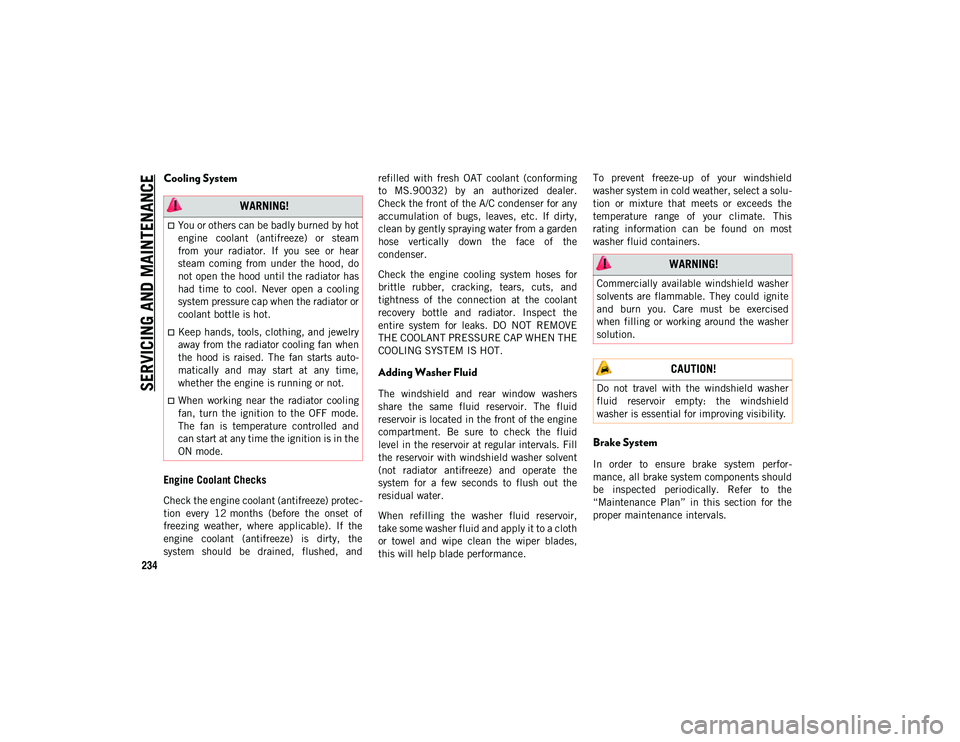
SERVICING AND MAINTENAN
CE
234
Cooling System
Engine Coolant Checks
Check the engine coolant (antifreeze) protec-
tion every 12 months (before the onset of
freezing weather, where applicable). If the
engine coolant (antifreeze) is dirty, the
system should be drained, flushed, and refilled with fresh OAT coolant (conforming
to MS.90032) by an authorized dealer.
Check the front of the A/C condenser for any
accumulation of bugs, leaves, etc. If dirty,
clean by gently spraying water from a garden
hose vertically down the face of the
condenser.
Check the engine cooling system hoses for
brittle rubber, cracking, tears, cuts, and
tightness of the connection at the coolant
recovery bottle and radiator. Inspect the
entire system for leaks. DO NOT REMOVE
THE COOLANT PRESSURE CAP WHEN THE
COOLING SYSTEM IS HOT.
Adding Washer Fluid
The windshield and rear window washers
share the same fluid reservoir. The fluid
reservoir is located in the front of the engine
compartment. Be sure to check the fluid
level in the reservoir at regular intervals. Fill
the reservoir with windshield washer solvent
(not radiator antifreeze) and operate the
system for a few seconds to flush out the
residual water.
When refilling the washer fluid reservoir,
take some washer fluid and apply it to a cloth
or towel and wipe clean the wiper blades,
this will help blade performance.To prevent freeze-up of your windshield
washer system in cold weather, select a solu
-
tion or mixture that meets or exceeds the
temperature range of your climate. This
rating information can be found on most
washer fluid containers.
Brake System
In order to ensure brake system perfor -
mance, all brake system components should
be inspected periodically. Refer to the
“Maintenance Plan” in this section for the
proper maintenance intervals.
WARNING!
You or others can be badly burned by hot
engine coolant (antifreeze) or steam
from your radiator. If you see or hear
steam coming from under the hood, do
not open the hood until the radiator has
had time to cool. Never open a cooling
system pressure cap when the radiator or
coolant bottle is hot.
Keep hands, tools, clothing, and jewelry
away from the radiator cooling fan when
the hood is raised. The fan starts auto-
matically and may start at any time,
whether the engine is running or not.
When working near the radiator cooling
fan, turn the ignition to the OFF mode.
The fan is temperature controlled and
can start at any time the ignition is in the
ON mode.
WARNING!
Commercially available windshield washer
solvents are flammable. They could ignite
and burn you. Care must be exercised
when filling or working around the washer
solution.
CAUTION!
Do not travel with the windshield washer
fluid reservoir empty: the windshield
washer is essential for improving visibility.
2020_JEEP_CHEROKEE_UG_RHD_UK.book Page 234